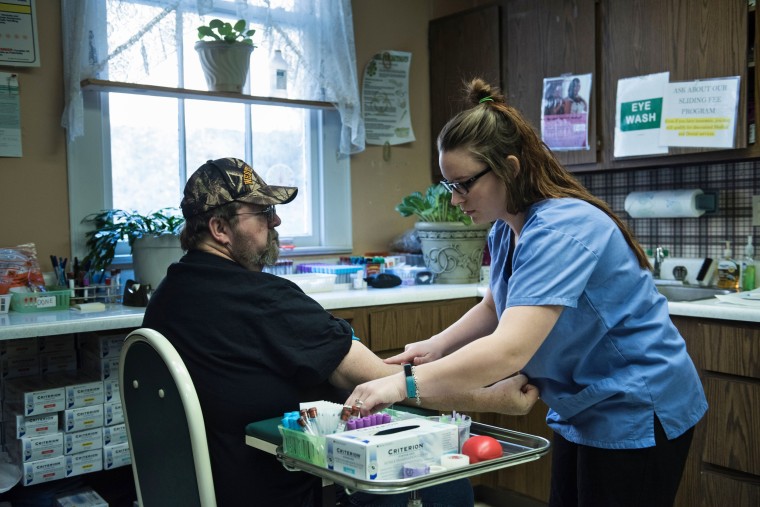More than 10,000 people in Appalachia will sigh with relief this month after two donors from the region helped nonprofit RIP Medical Debt purchase and forgive $10 million of medical debt. But it's just a drop in the bucket of the $88 billion of medical debt racked up in the United States over the past year.
“We’re going to get their current address and then there’s a special letter that’s going out to each of these people,” said RIP Medical Debt founder Craig Antico, who celebrated the fifth anniversary of the nonprofit Thursday. “It’s from the donors, and it’s going to tell them they’re part of a larger campaign. They’re going to get a letter in a yellow envelope that says this is a no-strings attached gift from people in the community.”
Antico said the $100,000 donation, which buys the $10 million debt for pennies on the dollar, came from two individuals — Jim Branscome, a former journalist who became the managing director of Standard & Poor’s Financial Services, and author and journalist Bill Bishop. The two men approached RIP Medical Debt in May and said they wanted to focus on Central Appalachia with their personal donation.
The 10,000 people affected are sprawled across 70 counties in West Virginia, Virginia and Kentucky. The nonprofit is unable to pinpoint individuals, but is able to purchase groups of people's debt in bulk from the debt market, which they did in this case.
The need in the region prompted RIP Medical Debt to start a new campaign as it identified $240 million of medical debt across the entire Appalachia region as defined by the Appalachian Regional Commission.
“I love the idea that people are abolishing debt in complete regions,” Antico said.

Jenifer Bosco, a staff attorney at the National Consumer Law Center and an expert on medical debt, said the rate of medical debt growth was assuaged slightly by the passage of the Affordable Care Act and the 36 states that decided to expand Medicaid, but the repeal of the individual mandate has caused that trend to reverse course.
Americans borrowed an estimated $88 billion to cover medical expenses in the 12 months prior to the publication of an April report produced by Gallup and West Health. The same survey found that 65 million Americans did not seek treatment or care because of the potential cost over the same period.
“Having better access to insurance has been helpful to reduce the amount of uncompensated care, but from a consumer perspective, medical debt is still a major problem,” Bosco said.
The high cost of medical expenses could be a tipping point for many: More than a quarter of Americans are a $400 bill away from having to borrow money or sell their belongings, according to a Federal Reserve study published earlier this year.
Approximately 1 in 6 Americans are contacted annually by debt collectors over a health care bill and 52 percent of collection items on credit reports are for medical debts, according to the National Consumer Law Center. Almost 60 percent of bankruptcy filers said they believed their medical debt was a contributor to their bankruptcy, the center said.
RIP Medical Debt has now identified $240 million of medical debt in the counties of Appalachia as defined by the Appalachian Regional Commission, and they hope to target that block specifically in the future.
“That’s going to be part of a bigger campaign to help in Appalachia,” Antico said. “We can target by geography and then further refine by plight: Are they poor, insolvent or are they in hardship?”
But Bosco said the very fact that the American health care system has reached a point where a nonprofit must cover individuals' debt shows the significant cracks within this structure.
It’s the same system that has forced people to turn to GoFundMe to pay for their medical bills. The crowdsourced fundraising site sees more than 250,000 medical campaigns per year and raises more than $650 million for those campaigns annually, Bosco said.
“GoFundMe has reported that medical care is one of the highest, if not the highest, frequencies of GoFundMe’s use,” she said. “That’s really indicative of the problems we’re having with our current system.”
Crowdsourcing has become so vital to people’s ability to afford medical bills that GoFundMe CEO Rob Solomon was named one of the 50 most influential people in health care by Time Magazine.
GoFundMe is not a health care company.
But without massive changes within the health care system in sight, some Americans may be left to turn to the generosity of the internet or pray that their plight is randomly chosen by an organization like RIP Medical Debt — which also uses crowdfunding service Qgiv to raise money.
“We’re going to hit [covering] a billion dollars of debt within the next two months,” Antico said. “And we’ve only just begun.”
